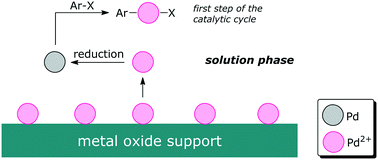当前位置:
X-MOL 学术
›
Catal. Sci. Technol.
›
论文详情
Our official English website, www.x-mol.net, welcomes your feedback! (Note: you will need to create a separate account there.)
Metallic palladium, PdO, and palladium supported on metal oxides for the Suzuki–Miyaura cross-coupling reaction: a unified view of the process of formation of the catalytically active species in solution
Catalysis Science & Technology ( IF 5 ) Pub Date : 2017-08-01 00:00:00 , DOI: 10.1039/c7cy01201b Alessandro Del Zotto 1, 2, 3, 4, 5 , Daniele Zuccaccia 1, 2, 3, 4, 5
Catalysis Science & Technology ( IF 5 ) Pub Date : 2017-08-01 00:00:00 , DOI: 10.1039/c7cy01201b Alessandro Del Zotto 1, 2, 3, 4, 5 , Daniele Zuccaccia 1, 2, 3, 4, 5
Affiliation

|
The Pd-catalysed Suzuki–Miyaura reaction is a powerful and widely used method for the synthesis of asymmetric biaryls, which has found increasing industrial application for the production of pharmaceuticals, fine chemicals and materials. Despite its widespread popularity, there is still a need to better understand some features of the whole process. Although the catalytic cycle is well established in all its key steps (aryl halide oxidative addition to Pd(0), transmetalation, C–C bond formation/reductive elimination of the coupling product), the effective nature of catalysis when a Pd-containing solid material is employed as the catalyst is still debated. More specifically, the question is whether the oxidative addition of Ar–X occurs on the surface of the catalyst (heterogeneous catalysis) or on leached metal atoms (homogeneous catalysis). This critical review is an attempt to answer this question, drawing upon findings from recent research based on the application of different forms of metallic palladium, PdO, and metal oxide-supported Pd catalysts to the Suzuki–Miyaura coupling. On the basis of the results of studies conducted so far, there is convergence towards a unique scenario, namely, the solid (pre)catalyst acts as a “reservoir” of soluble catalytically active palladium species. Furthermore, there is strong evidence, at least for catalysts of the type Pd/MxOy, that the noble metal is released in the form of Pd2+ ions, generally from amorphous PdO present on the surface.
中文翻译:

铃木-宫浦交叉偶联反应中负载在金属氧化物上的金属钯,PdO和钯:溶液中催化活性物质形成过程的统一视图
Pd催化的Suzuki–Miyaura反应是一种合成不对称联芳基的有力且广泛使用的方法,发现该方法在制药,精细化学品和材料生产中的工业应用日益广泛。尽管它广泛流行,但仍然需要更好地了解整个过程的某些功能。尽管在所有关键步骤中都建立了良好的催化循环(芳族卤化物氧化添加到Pd(0)中,金属转移,CC键形成/偶合产物的还原消除),当含Pd固体时催化的有效性质用作催化剂的材料仍在争论中。更具体地说,问题是Ar–X的氧化加成发生在催化剂表面(非均相催化)还是浸出的金属原子上(均相催化)。这次批判性评论是试图根据最近的研究结果来回答这个问题,该研究基于将不同形式的金属钯,PdO和金属氧化物负载的Pd催化剂应用于Suzuki-Miyaura偶联。根据迄今为止的研究结果,人们趋向于一种独特的情况,即固体(预)催化剂充当可溶性催化活性钯物质的“储存库”。此外,有充分的证据,至少对于Pd / M类型的催化剂 人们正在朝着一种独特的情况汇聚,即,固体(预)催化剂充当可溶性催化活性钯物质的“储存库”。此外,有充分的证据,至少对于Pd / M类型的催化剂 人们正在朝着一种独特的情况汇聚,即,固体(预)催化剂充当可溶性催化活性钯物质的“储存库”。此外,有充分的证据,至少对于Pd / M类型的催化剂x O y表示贵金属以Pd 2+离子的形式释放,通常是从表面上存在的无定形PdO中释放出来的。
更新日期:2017-09-18
中文翻译:

铃木-宫浦交叉偶联反应中负载在金属氧化物上的金属钯,PdO和钯:溶液中催化活性物质形成过程的统一视图
Pd催化的Suzuki–Miyaura反应是一种合成不对称联芳基的有力且广泛使用的方法,发现该方法在制药,精细化学品和材料生产中的工业应用日益广泛。尽管它广泛流行,但仍然需要更好地了解整个过程的某些功能。尽管在所有关键步骤中都建立了良好的催化循环(芳族卤化物氧化添加到Pd(0)中,金属转移,CC键形成/偶合产物的还原消除),当含Pd固体时催化的有效性质用作催化剂的材料仍在争论中。更具体地说,问题是Ar–X的氧化加成发生在催化剂表面(非均相催化)还是浸出的金属原子上(均相催化)。这次批判性评论是试图根据最近的研究结果来回答这个问题,该研究基于将不同形式的金属钯,PdO和金属氧化物负载的Pd催化剂应用于Suzuki-Miyaura偶联。根据迄今为止的研究结果,人们趋向于一种独特的情况,即固体(预)催化剂充当可溶性催化活性钯物质的“储存库”。此外,有充分的证据,至少对于Pd / M类型的催化剂 人们正在朝着一种独特的情况汇聚,即,固体(预)催化剂充当可溶性催化活性钯物质的“储存库”。此外,有充分的证据,至少对于Pd / M类型的催化剂 人们正在朝着一种独特的情况汇聚,即,固体(预)催化剂充当可溶性催化活性钯物质的“储存库”。此外,有充分的证据,至少对于Pd / M类型的催化剂x O y表示贵金属以Pd 2+离子的形式释放,通常是从表面上存在的无定形PdO中释放出来的。



























 京公网安备 11010802027423号
京公网安备 11010802027423号